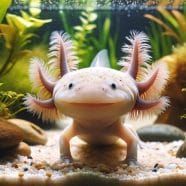Getting an axolotl pet is like stepping into a world of underwater magic. These fascinating creatures, with their fringed gills and wide-eyed stares, have captivated the hearts of many. But caring for them goes beyond mere fascination; it requires knowledge and commitment.
In this article, we’ll dive deep into crafting the ideal habitat to keep your axolotl happy and healthy. We’ll cover everything from tank requirements to water conditions, ensuring you’re equipped to create a perfect underwater haven.
You’ll also get the lowdown on what these critters love to eat and how often they should be fed to maintain optimal health. Plus, we tackle common health issues that can arise and how you can prevent or address them swiftly.
And because knowing is half the battle, we explore both sides—what makes axolotls great pets but also the challenges you might face with an axolotl pet. Lastly, understanding their behavior will help you provide not just for their physical needs but for their mental stimulation too.
Table Of Contents:
- Legal and Ethical Considerations for Keeping Axolotls as Pets
- Crafting the Ideal Axolotl Pet Habitat
- Axolotl Diet and Nutrition
- Common Health Issues in Axolotls
- Pros and Cons of Keeping an Axolotl as a Pet
- Understanding Axolotl Behavior and Social Needs
- To Axolotl or Not?
 AI illustration of Axolotl
AI illustration of Axolotl
Legal and Ethical Considerations for Keeping Axolotls as Pets
Before diving into the enchanting world of axolotl pet ownership, it’s crucial to understand both legal and ethical considerations. These unique amphibians require specific care, but first, let’s ensure you’re on solid ground with regulations and responsibilities.
Checking Legal Status in Your Area
The legality of keeping axolotls varies significantly from one region to another. In some places, they are protected species or considered invasive outside their native habitat in Mexico. Before making any decisions, check your local wildlife conservation laws or visit reputable websites such as the U.S. Fish & Wildlife Service. This step ensures that you comply with local regulations and supports conservation efforts for these fascinating creatures.
Can You Provide an Appropriate Environment?
Axolotls have specific habitat requirements that must be met to thrive in captivity. They need a large aquarium with cool water temperatures between 60°F and 64°F (16°C – 18°C), proper filtration to keep the water clean without creating strong currents, and a diet rich in nutrients found in live worms, small fish, and specialized pellets. Understanding these needs is paramount; failing to provide them can lead to health issues or even premature death for your pet axolotl.
- Tank Size: A minimum of a 20-gallon tank is recommended for one adult axolotl.
- Filtration System: Invest in a high-quality filter designed for delicate aquatic life.
- Dietary Needs: Balance their diet with both live food options like earthworms and quality pellets formulated specifically for carnivorous amphibians.
Ethical Breeding Practices
Breeding axolotls requires knowledge about genetic diversity, potential health issues related to poor breeding practices, such as morphological abnormalities or susceptibility to diseases, and commitment towards rearing offspring. Engaging responsibly means educating yourself beforehand—preferably consulting experts—and prioritizing animal welfare over personal gain. For more information on responsible breeding, The Amphibian Foundation offers comprehensive resources.
Owning an axolotl carries significant responsibility beyond just providing food and shelter; understanding its natural behavior and environment is essential for maintaining a happy and healthy life in a captive setting. By adhering to legal guidelines and ensuring you are capable of meeting their needs, you show respect for this incredible species and contribute positively to the overall ecosystem balance.
Crafting the Ideal Axolotl Pet Habitat
Creating a perfect home for your axolotl isn’t just about aesthetics; it’s crucial for their health and happiness. Think of it as setting up a mini aquatic playground that caters to all their needs.
Tank Requirements
A spacious tank is non-negotiable because axolotls love to move around. A 20-gallon tank is the minimum size for one, but if you plan on having more, add an extra 10 gallons per additional axolotl. Remember, bigger is always better in this case.
The shape of the tank matters, too. Go for longer tanks than taller ones since these creatures prefer roaming across the bottom over vertical swimming.
Water Conditions
Maintaining pristine water conditions is akin to giving your axolotl a clean bill of health. They thrive in cool temperatures ranging from 60-64°F (15-18°C), so consider investing in an aquarium chiller during those hot summer months or check out the best aquarium chillers guide to keep things cool.
pH levels should be kept stable between 6.5 and 7.5, with ammonia and nitrite levels at zero, making regular water testing paramount.
Find your 20 gallon starter kit at Amazon.
Axolotl Diet and Nutrition
Feeding your axolotl is more than just a daily chore; it’s an art form that ensures their health and vitality. Imagine crafting a menu for a unique underwater guest that thrives on variety and nutritional balance.
Preferred Foods
Axolotls are carnivorous creatures with a penchant for protein-rich foods. Their diet in the wild gives us clues about what they crave in captivity. Earthworms are an axolotl favorite, closely followed by bloodworms, brine shrimp, and soft pellets explicitly designed for them. Microworms or baby brine shrimp make perfect bite-sized meals for young axolotls or juveniles.
Remember to offer food that’s appropriately sized to avoid choking hazards. This might mean cutting larger food items into smaller pieces for younger or smaller axolotls.
Feeding Schedules
The age of your axolotl dictates its feeding frequency: juveniles require daily feedings due to their rapid growth phase, while adults do well with meals three times a week. Consistency is key—pick specific times during the day when you can sit back and watch them dine like royalty underwater.
Common Health Issues in Axolotls
With their alien-like appearance and fascinating regenerative abilities, Axolotls might seem invincible at first glance. But like any pet, they’re prone to certain health issues that can catch any axolotl parent off guard.
Fungal Infections
Fungi love moist environments, making axolotls prime targets for these pesky invaders. White cottony patches on your pet’s body are a dead giveaway. The key here is clean water and quick action. A thorough tank cleaning coupled with antifungal treatment often does the trick.
But prevention beats cure every time. Regularly checking your water quality can save you and your axie plenty of trouble down the line.
Digestive Troubles
Overfeeding or feeding inappropriate foods can lead to bloating or constipation in axolotls—no small matter, given their sensitive digestive systems. Watching what—and how much—your axie eats will keep them from tipping the scales into discomfort.
Variety isn’t just the spice of life; it’s also crucial for a healthy diet in these aquatic critters. Incorporate a mix of high-quality pellets, live worms, and occasional treats to ensure nutritional balance and digestive happiness.
Pros and Cons of Keeping an Axolotl as a Pet
Axolotls are unique, but they’re not for everyone. Here’s the lowdown to help you decide if one is right for you.
Pros
First off, axolotls have that cool factor. They look like something out of a fantasy novel with their frilly gills and smiley faces. Plus, they’re relatively low maintenance compared to other pets. You won’t need to walk them or clean up fur.
Their diet is straightforward; axolotls eat pellets, worms, and small fish, which are easy enough to get your hands on.
Last but not least, watching these creatures can be downright therapeutic. Their serene swimming could calm even the most frazzled nerves.
Cons
However, to thrive, axolotls require specific water conditions—cool temperatures between 60-64°F (16-18°C) and a neutral pH level. This might mean investing in special equipment like chillers or filters.
Another thing? These critters are sensitive souls; poor water quality can quickly lead to health issues. Common problems include fungal infections and stress-related illnesses.
Last point: They live long lives (up to 15 years.), so think about this commitment seriously before diving in.
Understanding Axolotl Behavior and Social Needs
Delve into the fascinating world of axolotl behavior, including social interactions, signs of stress, and how to provide a stimulating environment.
Axolotls might look like they’re always smiling, but understanding their social cues is crucial to keeping them happy. These aquatic critters are more complex than you’d think.
First off, axolotls enjoy their own company a bit too much sometimes. While some can coexist with others of their kind, it’s not a roommate situation for everyone. Monitoring interactions closely is essential because what looks like playful chasing could actually be stress or aggression in disguise.
Stress signs include gill flaring and excessive hiding. A stressed axolotl isn’t just sad; it’s also at risk of health issues. According to research on amphibian habitats, creating a stimulating environment with plenty of hideouts and low-flow filtration can make all the difference. So yes, that little castle decoration might be more important than you thought.
To Axolotl or Not?
Stepping into the world of an axolotl pet is a journey filled with learning and wonder. You’ve now got the essentials for setting up their perfect habitat, understanding what they need to eat, spotting health issues early, and appreciating the joys and challenges they bring.
Remember: Water quality can’t be compromised. Feed them right; it’s crucial for their health. Keep an eye out for signs of stress or illness.
Owning an axolotl isn’t just about enjoying their unique appearance; it’s about creating a stimulating environment that caters to their needs.
This underwater adventure demands commitment but offers endless fascination in return. Dive in with knowledge, patience, and care, and your axolotl pet will thrive under your watch.

